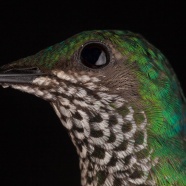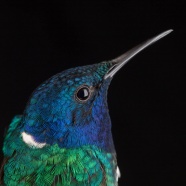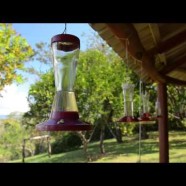White-necked Jacobin (Florisuga mellivora) Female
Here’s the female White-necked Jacobin (Florisuga mellivora) hummingbird showing off a beautiful zebra-like gorget as photographed by RTPI Affiliate Sean Graesser.
Read MoreWhite-necked Jacobin (Florisuga mellivora)
Here’s the White-necked Jacobin (Florisuga mellivora) hummingbird, and this photo by RTPI Affiliate Sean Graesser shows where their name comes from. He says he has seen five males at one time at the feeders in Costa Rica despite it being “out of range” for species in the area. RTPI President Twan Leenders says the local eBird reviewers give him a tough time about it…thankfully there is photographic proof!
Read MoreWhite-necked Jacobin (Florisuga mellivora)
The White-necked Jacobin (Florisuga mellivora) is one of the most uniquely colored hummingbird species in Central America. The adult males have this beautiful blue bib that has a splendid sheen to it. They can be found in many different habitat types making it an especially interesting species to study. Photographed by RTPI Affiliate Sean Graesser for the Meet Your Neighbours global biodiversity project in Costa Rica while on assignment for the Roger Tory Peterson Institute of Natural History.
Read MoreHummingbird frenzy!
Hummingbird frenzy! Check out all of these hummingbirds, sometimes over 50 at one time and several hundred in a short period, visiting feeders at Finca Pura Vida in Costa Rica. The most common species in the video is the Green-breasted Mango (Anthracothorax prevostii) with others including Long-billed Starthroat (Heliomaster longirostris), Blue-throated Goldentail (Hylocharis eliciae), Scaly-breasted Hummingbird (Phaeochroa cuvierii), White-necked Jacobin (Florisuga mellivora). There are also a few Ruby-throated Hummingbird (Archilochus colubris) in the mix! They may be in your backyard this...
Read MoreHummingbird banding begins
On December 3 we started hummingbird banding and research at Finca Pura Vida. To say these magnificent birds overwhelmed us is an understatement. We have been having feeders filled for us while we were away from our research station so that when we got here the birds would already be accustomed to the food source. We set our traps last night and filled all of our feeders to the brim to start early. On average over 50 individuals were feeding at one time and we had most likely over 300 individuals feeding in the time period we were working. We constantly had to close traps and nets to catch...
Read More








